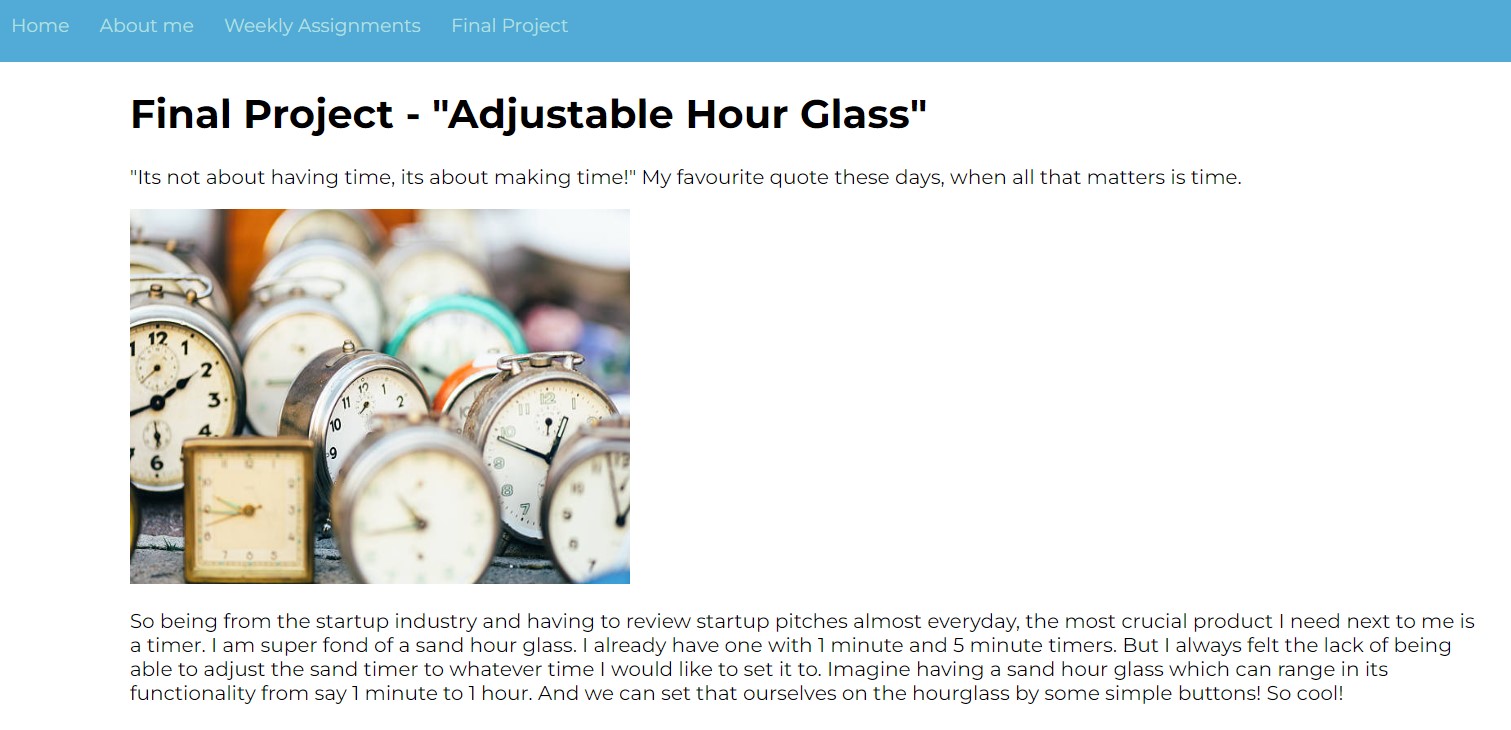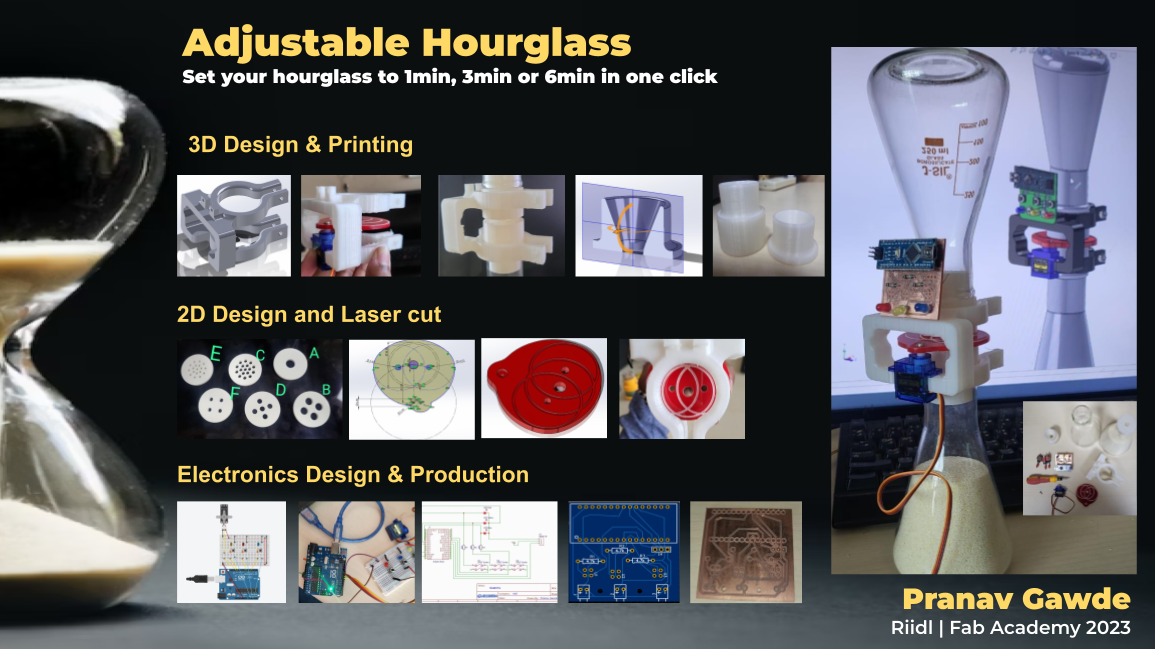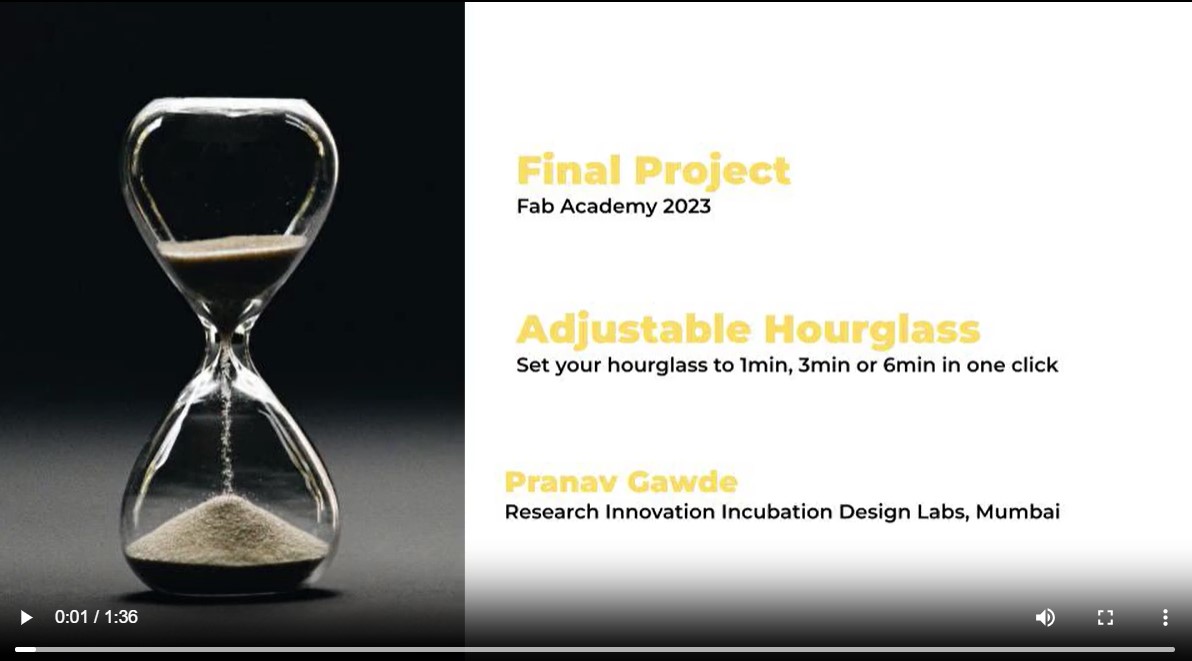17. Invention, Intellectual property and Business Models
This week we have to work on our final project. The detailed documentation of the final project can be viewed here:

The drafts for the summary slide and the final video was prepared this week.
Summary Slide

Final Video

Dissemination Plan
So let's start with some thoughts dumping first!Invention is making something new for the first time whether it be a device or a process, but invention on its own is never enough. There can be many examples of inventions, but if all those inventions would have been only kept aside after inventing by anybody then we would not have known about those and even wouldn't have been so developed what we are now. So basically after invention, Commercialization is the most important key to bring it in front of the world, that is what completes the whole process of Innovation (Invention & Commercialization).
Motivation behind making an hourglass for the final project
The motivation to build this project was anyways not bout inventing something or commercialising anything. It was more or less about sovling a custom problem and making things I would personally ove to use based on my interest.So being from the startup industry and having to review startup pitches almost everyday, the most crucial product I need next to me is a timer. I am super fond of a sand hour glass. I already have one with 1 minute and 5 minute timers. But I always felt the lack of being able to adjust the sand timer to whatever time I would like to set it to. Imagine having a sand hour glass which can range in its functionality from say 1 minute to 1 hour. And we can set that ourselves on the hourglass by some simple buttons! So cool!
Intellectual Property
Intellectual property (IP) refers to the legal rights and protections granted to individuals or entities for their creations or inventions. It encompasses various forms of intangible assets, including inventions, artistic works, brand names, logos, designs, and trade secrets. Intellectual property rights provide exclusive ownership and control over these intangible assets, allowing creators to benefit from their work and prevent others from unauthorized use or exploitation.There are several types of intellectual property rights:
1.Patents
A patent is an exclusive right granted for an invention, which is a product or a process that provides, in general, a new way of doing something, or offers a new technical solution to a problem. To get a patent, technical information about the invention must be disclosed to the public in a patent application.
2.Copyrights
Copyright (or author’s right) is a legal term used to describe the rights that creators have over their literary and artistic works. Works covered by copyright range from books, music, paintings, sculpture, and films, to computer programs, databases, advertisements, maps, and technical drawings.
3.Trademarks
A trademark is a sign capable of distinguishing the goods or services of one enterprise from those of other enterprises. Trademarks are protected by intellectual property rights.
4.Trade Secrets
Trade secrets are intellectual property (IP) rights on confidential information which may be sold or licensed.
5.Industrial Design
In a legal sense, an industrial design constitutes the ornamental aspect of an article. An industrial design may consist of three dimensional features, such as the shape of an article, or two dimensional features, such as patterns, lines or color.
Adjustable Hourglass as an Innovation
So making an adjustable hour glass is not a ground breaking thing as it is already been made by companies like Tempo. But being able to make it with more features to it or a better redesign can surely benefit to the other wing of Innovation, i.e. Commercialisation. Initially, as described above, the aim was to just make a nice functional hourglass for my own use. But after realising the love for hourglasses in general and the need to have a adjustable one, it can easily be commercialised. It would obviously be a niche market with B2C business model but would be worth giving it a try! The go-to-market strategy could potentially be social media promotions and sales alongwith Amazon and other players selling it online through their distribution network. The reason being, it would be hard to have our own distribution network and handling logidtics and supply chain for such a niche market without converting it into a startup and raising some funds. But even if I convert it into a business, I need to add more products to the list to sustain.Also, before that, we need to push the product above the TRL line. The final outcome of the project is just a TRL 3 version with lot of modifications possible. The modifications needed are discussed in detail in the Final project page. But in general, the body needs to be improvised a lot. The shape at the bottle neck right now is too bulky with all the electronics around. It can be squeezed down to as minimal as it can get and then the body could look a bit more aesthetic. Also the ergonomics is not thought upon right now and thus the bottle neck design is very crucial as that is the only major point of interation for the users.
Revenue model post the final product at TRL9 can be well defined. But as of now, things can be estimated and thus based on my BOM (again mentioned in the Final project page.), the selling cost per pc of an adjustable hourglass should be around Rs. 5000 atleast.
Brand Identity
So I realised while writing all this that it needs to have a name at first place. We can't keep it calling adjustable hourglass. It needs to have a name! So that's where brand identity comes into picture.In terms of brand identity, the want to define the company name as just my own freelance identity atleast as of now. So I used to sell my canvas paintings through my brand identity. I would just use the same for the company. The product name will be "Flip it". We can design a Flip it! logo, and define color schemes for the same.